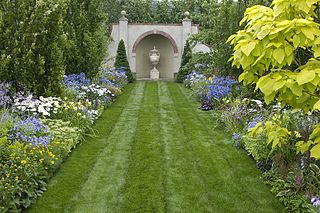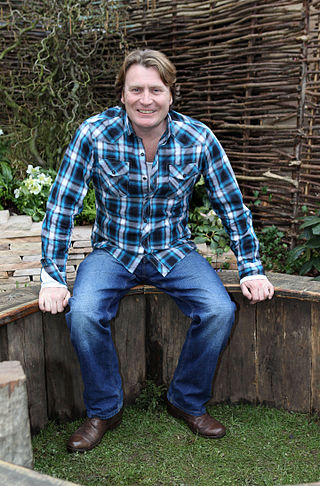
The Royal Horticultural Society (RHS), founded in 1804 as the Horticultural Society of London, is the UK's leading gardening charity.

The RHS Chelsea Flower Show, formally known as the Great Spring Show, is a garden show held for five days in May by the Royal Horticultural Society (RHS) in the grounds of the Royal Hospital Chelsea in Chelsea, London. Held at Chelsea since 1912, the show is attended by members of the British Royal Family.

Floristry is the production, commerce, and trade in flowers. It encompasses flower care and handling, floral design and arrangement, merchandising, production, display and flower delivery. Wholesale florists sell bulk flowers and related supplies to professionals in the trade. Retail florists offer fresh flowers and related products and services to consumers. The first flower shop in the United States opened prior to 1851.
RHS Britain in Bloom is the largest horticultural campaign in the United Kingdom. It was first held in 1963, initiated by the British Tourist Board based on the example set by Fleurissement de France, which since 1959 has promoted the annual Concours des villes et villages fleuris. It has been organised by the Royal Horticultural Society (RHS) since 2002.

Aeonium, the tree houseleeks, is a genus of about 35 species of succulent, subtropical plants of the family Crassulaceae. Many species are popular in horticulture. The genus name comes from the ancient Greek αἰώνιος / aiōnios (ageless). While most of them are native to the Canary Islands, some are found in Madeira, Cape Verde, Morocco, in East Africa and Yemen.

The Hampton Court Garden Festival is an annual British flower show, held in early July. The show is run by the Royal Horticultural Society (RHS) at Hampton Court Palace in the London Borough of Richmond upon Thames. The show features show gardens, floral marquees and pavilions, talks, and demonstrations. Erected on the north and south sides of the Long Water in Hampton Court Park, it is the second major national show after the Chelsea Flower Show, but has a different character, focusing more on environmental issues, growing your own food and vegetables and cookery, as well as selling gardening accessories, plants and flowers.

RHS Flower Show Tatton Park held at Tatton Park, near Knutsford, Cheshire, first began in 1999 by the Royal Horticultural Society. The show houses the RHS National Flower Bed Competition, Young Designer of the Year Award and a wide range of inspirational show gardens, smaller 'Back to Back' gardens, visionary gardens and a number of marquees displaying prize plants and flora exhibits. Other key features of the show are the floral marquee and plant plaza, the arts and heritage pavilion, and the floral design studio.

Floral design or flower arrangement is the art of using plant materials and flowers to create an eye-catching and balanced composition or display. Evidence of refined floristry is found as far back as the culture of ancient Egypt. Professionally designed floral designs, arrangements or artwork incorporate the elements of floral design: line, form, space, texture, and color, and the principles of floral design: balance, proportion, rhythm, contrast, harmony, and unity.
Judith Blacklock is an author and owner and founder of the Judith Blacklock Flower School.
Smithers-Oasis is a company specializing in floristry products headquartered in Kent, Ohio, United States. The company created water-absorbing foam in 1954.
Frances Mary Perry MBE VMH was an English gardener, administrator, writer and broadcaster.
Roy Hay MBE, VMH was a British horticultural journalist and broadcaster. He was the author of many publications and the instigator of many organisations and events, including the annual Britain in Bloom competition.
Paul Hervey-Brookes is an multi-award-winning garden designer and plantsman who lives between the Cotswolds, England And the Loire Valley in France.
Julia Clements was an English flower arranger and lecturer on floral arranging whose career spanned over 60 years. She wrote some 20 bestselling books on the subject of flower arranging, as well as contributing to a variety of publications on gardening. For 12 years, she wrote a column for Popular Gardening.

A rose show is a horticultural exhibition focusing exclusively on roses.

David Martin Domoney, C Hort. FCI Hort is an English Chartered Horticulturist and celebrity gardener. He co-presents the TV gardening programme Love Your Garden, alongside Alan Titchmarsh, and is the resident gardener on ITV1's This Morning.[3]

A garden club is an organized group of people with a shared interest in gardening, gardens, and plants. A flower club is a similar group with a focus on flowers.

Stuart Meeson is a physicist who having done research in Electrical Impedance Tomography and Mammography has been working in Computed Tomography (CT) with the Radiology Group of the University of Oxford. Areas of particular interest include imaging the cervical spine, abdominal sepsis and low contrast features in the abdomen and liver. His work in CT led to a collaborative study with the UK Health Protection Agency on the Third UK national CT dose survey.
Mary Shirville was an author and flower arranger. She was co-author of the constitution of the National Association of Flower Arrangement Societies (NAFAS) in the UK and its national chair from 1983 until 1985.
Pamela Underwood, born Pamela Richenda Cubitt Montgomery-Cuninghame and later known as Mrs Desmond Underwood, was a British florist and nursery woman. She was an early enthusiast for flower arranging and she wrote about "Grey and Silver Plants".










